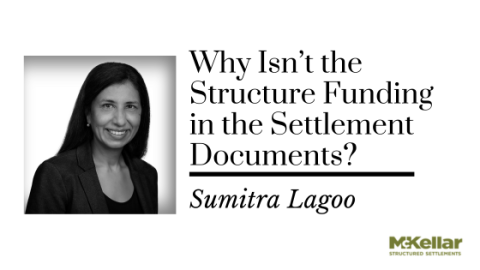
Those of you who work with us know that at McKellar, our Legal Department will assist in ensuring the Final Release or Judgment/Order applicable to your structured file is structure-compliant from a Canada Revenue Agency (CRA) perspective. Properly drafted documents are essential in order to establish the tax-free status of the structure payments.
But what, really, makes that documentation “structure-compliant”?
One of the most frequent questions we receive from clients on all sides of the structure is: “Why is the structure funding amount missing from this settlement document?”
The answer: CRA considers each individual periodic structure payment, not the amount required to fund the payments, plus any settlement amount NOT structured, to be the actual consideration for the settlement. In other words, if you’ve settled a claim for $800,000.00 “all-inclusive” and $500,000.00 is structured, as far as CRA is concerned that claim has settled for:
- $300,000.00 in cash outside of the structure; and
- the promise of the periodic payments shown in the structured settlement payment schedule (which is attached to the documents, usually as Schedule “A”). Those payments are funded with $500,000.00 in our example.
CRA has historically objected to the inclusion of the structure premium in the body of the settlement documentation itself, as it may give rise to the issue of constructive receipt. CRA has not, however, objected to the structure funding being listed on the accompanying payment schedule, which should always be attached.
A structured settlement always pays more than the funding amount, over time. Consider our example above. If the $500,000.00 structure pays $700,000.00 in total payments by the end of the structure term, CRA views the entire $700,000.00 of payments as tax-free. Therefore, it is not accurate to list $500,000.00 as part of the “settlement consideration”. Rather, the settlement documents must refer to the periodic payments, including the conditions upon which they were established, in order to comply with CRA’s technical requirements to view the payments as non-taxable damages.
In situations where the structure premium must be noted for other reasons (e.g. Pierringer Agreement, Mary Carter Agreement), our Legal Department will work with counsel to ensure draft documents reflect the agreement between the parties, while still maintaining CRA’s technical requirements to keep the structure payments tax-free.
ABOUT SUMITRA LAGOO
Before joining McKellar, Sumitra practiced personal injury law in Hamilton for 15 years. Her legal and client relation skills will continue McKellar's tradition of unparalleled client service. To learn more about Sumitra, check out her bio here, or contact her directly here.